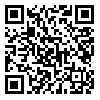Volume 22, Issue 85 (8-2022)
refahj 2022, 22(85): 159-179 |
Back to browse issues page
Research code: A-10-3855-1
Download citation:
BibTeX | RIS | EndNote | Medlars | ProCite | Reference Manager | RefWorks
Send citation to:



BibTeX | RIS | EndNote | Medlars | ProCite | Reference Manager | RefWorks
Send citation to:
Eslami S, Kabini Moghadam S, Nasser F. (2022). High Risk Social Behaviors in Adolescent Students of Guilan. refahj. 22(85), 159-179.
URL: http://refahj.uswr.ac.ir/article-1-3857-en.html
URL: http://refahj.uswr.ac.ir/article-1-3857-en.html
Abstract: (1340 Views)
Introduction: High-risk behaviors in any society are considered as one of the major threats to the health system. Because adolescents are more at risk than other age groups, they are more prone to this type of behavior. The purpose of this study was to investigate the prevalence of high-risk social behaviors among adolescent students in Guilan province.
Method: This research was conducted by contextualization method. The statistical population of the study included 182,637 high school students in Guilan province in 1399 (2020), of which 384 were selected as a sample by multi-stage cluster sampling. Zizadeh-Mohammadi and Ahmadabadi’s (2008) risk scale was used to collect the required data. To analyze the data at the descriptive level, frequency statistical methods, graphs and at the inferential level, non-parametric Kruskal-Wallis and Euman-Whitney tests were used. All statistical operations were analyzed by SPSS16 software. The significance level was considered 0.05 for all tests.
Findings: Aggressive behaviors, drug use, high-risk driving, relationship with the opposite sex, and sex with the opposite sex were the most common among students, respectively. The results also showed that the prevalence of high-risk behaviors among adolescents did not differ significantly based on their age, gender, educational level and field of study.
Discussion: Student community is faced with high-risk behaviors and to treat these problems, all the capacities of organizations and professionals, including psychologists and sociologists should be used.
Method: This research was conducted by contextualization method. The statistical population of the study included 182,637 high school students in Guilan province in 1399 (2020), of which 384 were selected as a sample by multi-stage cluster sampling. Zizadeh-Mohammadi and Ahmadabadi’s (2008) risk scale was used to collect the required data. To analyze the data at the descriptive level, frequency statistical methods, graphs and at the inferential level, non-parametric Kruskal-Wallis and Euman-Whitney tests were used. All statistical operations were analyzed by SPSS16 software. The significance level was considered 0.05 for all tests.
Findings: Aggressive behaviors, drug use, high-risk driving, relationship with the opposite sex, and sex with the opposite sex were the most common among students, respectively. The results also showed that the prevalence of high-risk behaviors among adolescents did not differ significantly based on their age, gender, educational level and field of study.
Discussion: Student community is faced with high-risk behaviors and to treat these problems, all the capacities of organizations and professionals, including psychologists and sociologists should be used.
Type of Study: orginal |
Received: 2021/02/26 | Accepted: 2022/06/7 | Published: 2022/08/8
Received: 2021/02/26 | Accepted: 2022/06/7 | Published: 2022/08/8
Send email to the article author
| Rights and permissions | |
 |
This work is licensed under a Creative Commons Attribution-NonCommercial 4.0 International License. |







